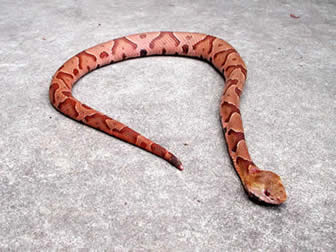Copperhead Snake Bite

By Michael Page
In most years, the Copperhead snake (Agkistrodon contortrix) is responsible for delivering more snake bites than any other snake species in the United States. Fortunately enough, the Copperhead snake bite contains mild venom compared to many other snake species. This does not mean that a Copperhead snake bite should be left without medical attention. The Copperhead snake is a pit viper with potent venom that can cause serious pain, extensive scarring and loss of use in bitten limbs and medical attention is therefore always recommended. The Copperhead snake bite is rarely fatal for healthy adults, but the venom is strong enough to cause local tissue damage. It is also not uncommon to develop a secondary infection in the wound.
Small pets are more sensitive to the Copperhead snake bite than larger mammals and humans. Pet dogs are frequently bitten by Copperheads in the United States since the dogs attack the snake, and it is not uncommon for these bites to prove fatal for the dog, especially if it is a small dog.
Even though a lot of people receive Copperhead snake bites in the United States each year, many of the wounds only need minor medical treatment and it is only a small percentage of the bitten persons who develop severe Copperhead snake bite symptoms. Earlier, this was believed to be thanks to the comparatively mild venom that is injected during a Copperhead snake bite. The venom is for instance milder than both cottonmouth and rattlesnake venom.
Recent research has however indicated that another factor also may play a part here. The Copperhead snake seems to use semi-serious bite-attacks as a way of scaring off an aggressor, just like a rattlesnake would rattle its tail. Since such a Copperhead snake bite is a sign of aggression rather than a really serious bite, the snake will only inject a small dose of venom. Producing venom is an energy consuming task, so if a snake can scare away an aggressor without using up all its valuable venom it will naturally prefer to do so.
If left with a choice, most snake species will prefer to escape from a potentially threatening situation instead of biting, and this is true for the Copperhead too. When escape is impossible, the Copperhead snake is however renowned for attacking quite rapidly, while many other snake species continue to display aggressive warning sings instead of actually biting. The new research shows us that this might be because semi-serious attacks are in fact a “warning sign” displayed by the Copperhead. If a person is close enough when the Copperhead lashes out, he or she may receive a penetrating Copperhead snake bite. Since it is only a threat display, the snake will however be sparing with its venom and only inject a small dose.
Avoid Copperhead snake bite
- A lot of people receive Copperhead snake bites every year because they try to move or kill Copperheads. If you notice Copperheads under your house, in your lawn etcetera and want to get rid of them, it is always recommended to call an expert instead of trying to deal with the problem yourself.
- Copperhead snakes never consider humans prey. If you leave the Copperheads alone, they will usually show you the same courtesy.
- You can warn the Copperhead snake of your presences by stomping when you go near places where you suspect that their might be Copperheads. Snakes easily detect vibrations in the ground and will choose to escape rather than stay and attack you.
- Teach your children to stay away from snakes. There is no need to instil snake phobia in your kids, simply explain to them that most snakes are harmless but that some snakes can deliver painful bites and that it therefore is a good idea to keep away from all types of snakes that they encounter in the wild.
This article about Copperhead snake bite is about the American Copperhead snake, Agkistrodon contortrix. It contains no information about Copperhead snake bites delivered by the Asian Copperhead Rat Snake (Elaphe radiata) or the Australian Copperhead snakes from the genus Austrelaps.
Copperhead Snake articles:
Baby Copperhead Snake
